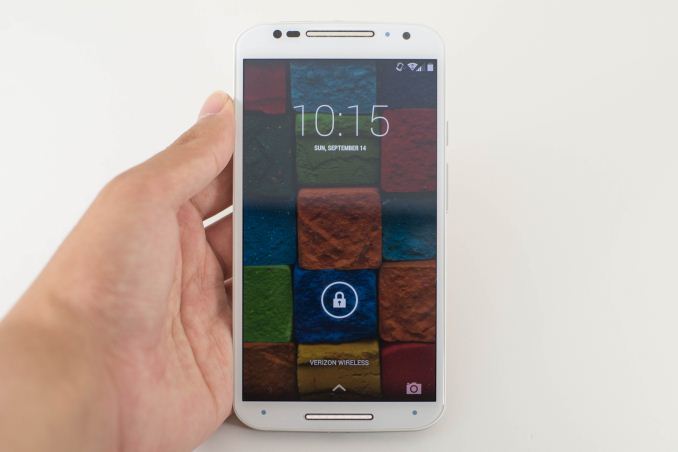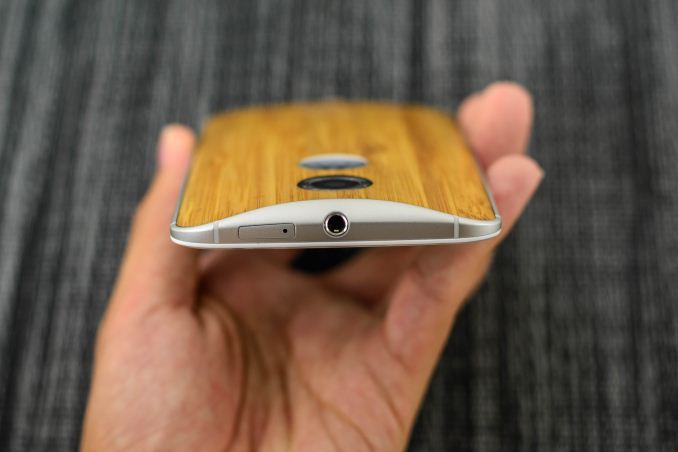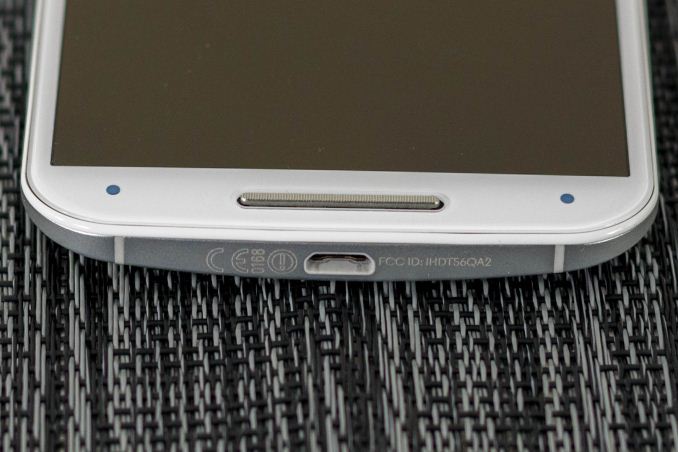The New Motorola Moto X (2nd Gen) Review
by Joshua Ho on September 17, 2014 9:00 AM EST- Posted in
- Smartphones
- Motorola
- Android
- Mobile

Introduction
While I talked about Motorola’s issues in the launch article for the new Moto X, it’s well worth repeating. Motorola has been through a lot these past few years. Once the iconic symbol of Android with their Droid smartphones, Motorola had lost its way. It wasn’t unusual to see one phone launch after the other, with no real regard for strategy, and no real cohesive message to tie all of their devices together. If anything, there was a point where Motorola had become an ODM for network operators in the US, with no real international presence. After Google acquired it in 2012, we saw the launch of the Moto X in 2013. The amount of hype that I saw online before the announcement of the Moto X was unlike anything I’ve ever seen.
Unfortunately, the device that launched didn’t quite fit with the hype. The Snapdragon S4 Pro chipset was decidedly mid-range by the time it launched. The display was good for the time, but AMOLED wasn’t quite the imminent LCD replacement that it is today. The camera was also rather unfortunate at launch. For better or worse, the Moto X was a phone with the right size and shape, but a lot of hardware choices that aged poorly. This leads us to the new Moto X. On the surface, this phone corrects a lot of issues that were present in the original Moto X. The new Moto X brings an SoC that is up to par with its competition, a new camera with a Sony sensor, and an improved AMOLED panel. Of course, I’m not going to spend too much time covering the basic specifications when a table will suffice.
| Motorola Moto X (Gen 1) | Motorola Moto X (Gen 2) | |
| SoC | 1.7 GHz Dual Core Snapdragon S4 Pro | 2.5 GHz Quad Core Snapdragon 801 |
| RAM/NAND | 2 GB, 16/32/64GB NAND | 2GB, 16/32GB NAND |
| Display | 4.7” 720p Super AMOLED | 5.2” 1080p Super AMOLED |
| Network | 2G / 3G / 4G LTE (Qualcomm MDM9x15 IP block UE Category 3 LTE) | 2G / 3G / 4G LTE (Qualcomm MDM9x25 IP block UE Category 4 LTE) |
| Dimensions | 129 x 65.3 x 5.7-10.4mm, 139 grams | 140.8 x 72.4 x 3.8-9.9 mm, 144 grams |
| Camera | 10MP Rear Facing, 1/2.6" CMOS size (OV10820), 2.1MP FFC | 13MP Rear Facing, 1/3.06" CMOS size (Sony IMX135), 2.1MP FFC |
| Battery | 2200 mAh, 3.8V, 8.36 Whr | 2300 mAh, 3.8V, 8.74 Whr |
| OS | Android 4.4.4 | Android 4.4.4 |
| Connectivity | 802.11a/b/g/n/ac + BT 4.0, USB2.0, GPS/GNSS, MHL, DLNA, NFC | 802.11a/b/g/n/ac + BT 4.1, USB2.0, GPS/GNSS, MHL, DLNA, NFC |
| SIM Size | NanoSIM | NanoSIM |
As with most reviews, physical impressions are always a good place to start. In terms of look and feel, the new Moto X starts off incredibly well. The metal frame is something that Motorola is especially proud of, as they've managed to enable an external antenna design without causing some of the infamous deathgrip issues. At any rate, it really feels great in the hand, especially because of the varying thickness. The metal frame can be as thin as 3.3mm in the corners, which really feels razor thin. Fortunately, the center is much thicker to provide for better grip. As a result, the phone is secure in the hand and I never really felt like I would drop it. Overall, I really think the feel of the phone is great. While the size is approaching an uncomfortable level, it manages to stay just short of it because the phone is so thin.
However, I’d like to cut this short as I’ve already given most of my initial impressions in the launch piece. While I haven’t been able to get around to writing my experience with Motorola’s tour, Motorola and their PR team have done an incredible job of introducing the product and allowing for plenty of time to get first impressions, photos, and ask all kinds of questions.
Cellular Architecture
Instead, given the amount of information disclosed by Motorola, I wanted to start this review with a discussion about cellular architecture, as it’s one of the few areas where we still seem to be working with black boxes. For those that are unfamiliar with the basics of how current RF architecture is set up, there are a few major components to talk about. We have antennas, antenna switches and duplexers, band filters, power amplifiers, a transceiver (which is made of multiple parts but that’s for another day), and the modem.
So let’s talk about what’s in the new Moto X. While antennas are still an area I’ve been working on learning more about, we can talk about band support on the Moto X. I’ve attached a table below with a full list of supported bands.
| Motorola Moto X (2014) | ||||||||
| FCC ID | Operator/Region Target | CDMA Bands | GSM | WCDMA | LTE | CA | ||
| IHDT56QA1 (XT1095/XT1097) | AT&T/T-Mobile USA | - | 850, 900, 1800, 1900 | 850, 900, AWS, 1900, 2100 | 2, 3, 4, 5, 7, 17, 29 | - | ||
| IHDT56QA2 (XT1096) | Verizon | 800, 1900 | 850, 900, 1800, 1900 | 850, 900, 1900, 2100 | 2, 3, 4, 7, 13 | - | ||
| IHDT56QA3 (XT1092) | ? | 800, 1900 | 850, 900, 1800, 1900 | 850, 900, AWS, 1900, 2100 | 2, 4, 5, 12, 17, 25, 26, 41 | - | ||
| IHDT56QA4 (XT1093/XT1094) | EU | - | 850, 800, 1800, 1900 | 850, 900, 1800, 1900, 2100 | 1, 3, 7, 8, 20 | - | ||
What might be notable is the lack of carrier aggregation on the new Moto X, which suggests that there is only a WTR1625L transceiver inside, with no WFR1620 companion chip to go with it. This is a rather conventional configuration at this point, and I suspect that phones with support for carrier aggregation will have to wait until WTR3925 which should be in most high end phones in 2015. The modem is also common at this point, as the MDM9x25 IP block in Snapdragon 800/801 has been around since the LG G2 which launched a year ago.
Of course, the real story here is the antenna tuner which I also wrote about in the launch piece. While most of the antenna tuner is hidden from view, there is one aspect that seems to be exposed to the OS. This one aspect is Cypress Semiconductor’s CapSense controller. This sounds strange, but I don’t think there’s any other explanation for why this controller is present. While it’s normally used for capacitive buttons such as in the Samsung Galaxy S/Galaxy Note line, there are no capacitive buttons or sliders present on the phone. In addition, none of the gestures/actions seem to rely upon capacitive sensing. This seems to rely upon the IR sensor system instead, so that doesn’t make sense either. The touchscreen is definitely an Atmel solution. This leaves the antenna tuner. While a bit outlandish, it seems that this controller is capable of detecting capacitance directly in addition to determining whether a finger/hand is on the sensor or not. While I’m sure that it’s necessary for Motorola to measure the standing wave ratio/signal reflection in addition to capacitive sensing on the relevant antenna pieces, this could give Motorola’s antenna tuner an advantage in speed as the capacitive sensors could detect the change in capacitance and pre-emptively change the tuning in the antennas instead of waiting for an increase in signal reflection before attempting to retune the antenna.













179 Comments
View All Comments
Endda - Wednesday, September 17, 2014 - link
and the Sony Xperia Z3 CompactNBMTX - Thursday, September 18, 2014 - link
The Z1f outsold the iPhone in Japan and it's seemingly only getting more premium AND more durable at the same time with the Z3c... though I like the Z1f/c's sides a bit more than the Z3c's.piroroadkill - Wednesday, September 17, 2014 - link
Alpha is a PoS compared with Z3 Compact.NBMTX - Thursday, September 18, 2014 - link
+1,000,000I would have really liked Moto to have gone head to head with the new iPhone staying at [a more compact] 4.7" with a much better sRGB calibrated display, a tested and quality 8mp camera with ois, a decent headphone amp (more important than stereo speakers, imo) with at least decent headphones, an included turbo charger, and something amazing like shell cordovan leather (vs delicate current options) that would [theoretically] only get better with the level of use our phones get...I think with small changes like that, it could have easily unseated the iP6 as a "premium device with attention to detail"...
wffurr - Wednesday, September 17, 2014 - link
I was pretty disappointed to see the new Moto X go to the larger screen size. I think Apple nailed it with different devices at 4.7" and 5.5". I wish Moto had kept the X at 4.7" and just upgraded the internals, maybe done the metal band thing, and introduced a new larger phone as a separate model.Maybe they don't have the internal resources to do two models, so they had to compromise and release a phone that's too big for one hand but not big enough to compete with the Note or iPhone 6+. That seems like a really poor choice to me, if so.
NBMTX - Thursday, September 18, 2014 - link
I'm with you but my guess is they simply settled on making it directly in between both sides of the argument... which makes sense. I guess.Also, Apple's 4.7" is fairly different than Moto's 4.7", if it's Nexus 5 like dimensions (but thin, with rounded edges) are anything to go by. Moto's was perfect, IMO. I'm glad the curvature is seemingly here to stay.
fokka - Wednesday, September 17, 2014 - link
wonderfully put. also, if they wanted to be part of the 5-inch crowd so bad, why not just make it 5 inches? why go for 5.2?they should just have stayed at 4.7", that was a big part of what made the x stand out in the first place. a more efficient SoC, bigger battery, better camera and maybe, just maybe, even an sd slot and they would've been good for another year.
but as nice as the new x looks, now we have yet another phablet sized phone with mediocre runtime and mediocre camera.
soccerballtux - Thursday, September 18, 2014 - link
having the Nexus 5, I think it's just a bit too small, but every 5.2" phone I use, I feel is perfect. 5.5" too big, but not 5.2.kasakka - Wednesday, September 17, 2014 - link
Agreed. It's not a coincidence that Apple went with 4.7" for the iPhone 6. It's probably the perfect display size for a smartphone at the moment, provided the bezels are very slim. As an owner of the Galaxy S4, I feel it is just a tiny bit too big to hold and use comfortably with one hand.I truly hope the trend swings around soon and manufacturers realise that there is a good market for slightly smaller, high performance phones. In Japan I had the pleasure of trying the Sharp Aquos XX Mini (4.5") and it was pretty amazing (battery life at such a small size w/ 1080p screen is questionable though) and would've bought it if it had had support for 3G/LTE in my country.
soccerballtux - Thursday, September 18, 2014 - link
I am not the only one that thinks 5.2" is the sweet spot and wishes my Nexus 5 had a 5.2" screen.